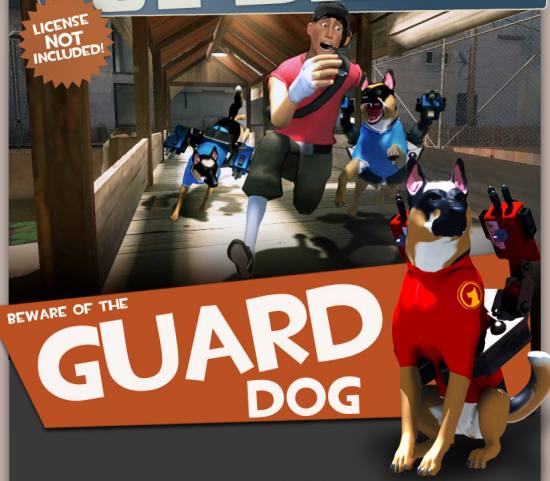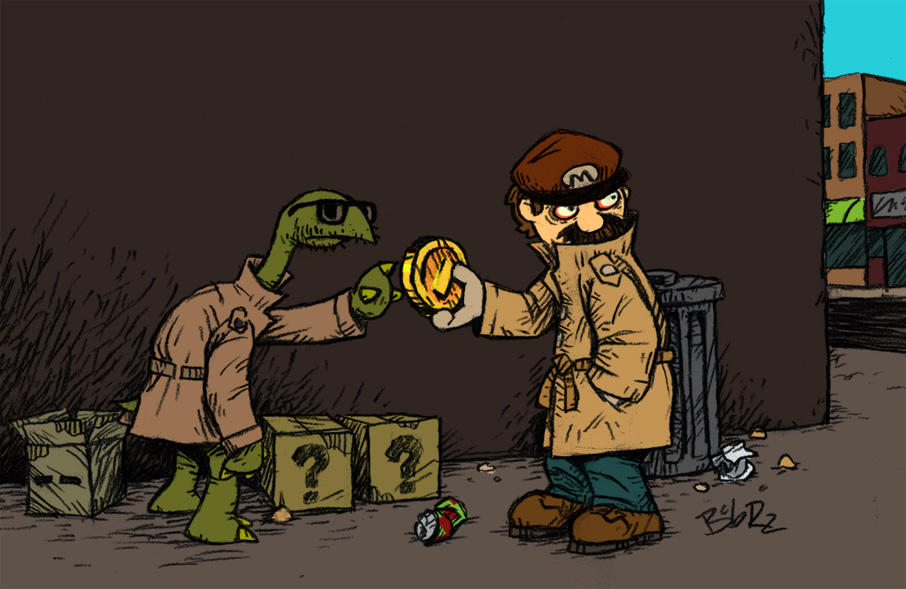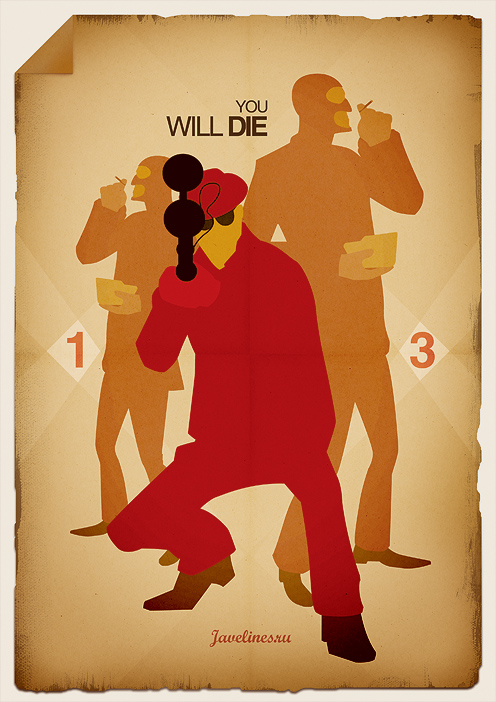I had to laugh at this. It’s some very good fan art (similar to the official updates). Valve has a good sense of humor about it, too. Check out their letter.
Author Archives: Brit
Empires of Steel Demo has been Released
A demo of Empires of Steel is now available. You can download it here.
Wolfenstein RPG
Spotted in the screenshots of Wolfenstein RPG:
It’s Soul Patch Hitler! I wonder if goatee-wearing Hitler is the really evil one.
(My guess? Images of Hitler aren’t allowed in Germany. Soul-patch Hitler, on the other hand, is okay. He’s cool and groovy with a soul-patch.)
‘Shrooms Addict
Joystiq: What’s In A Name
Joystiq has been running a few articles about how companies got their name. The story behind Stardock:
“I was in college and started the company to help pay for school until I could get a real job. I needed to get a computer and got a hold of a wholesale distributor to get the parts to build it. When I called, they asked me what the name of the company was and in panic, I looked around and was reading a book by Raymond E. Feist and the chapter was called ‘Stardock’ so that’s what I said the company’s name was. It stuck and has been since.”
Wow, he came up with a name on the spur of the moment.
The story Randy Pitchford tells about Gearbox (of Half-Life fame) is a little more harder to believe. It involves a high-stakes late night poker game in New Orleans with Gabe Newell. And, if that tall-tale didn’t trip your BS detector, it appears that Valve and Gearbox are now confirming that the story is a fabrication. I wonder if Pitchford was just seeing how far he could string Joystiq along with that unlikely story.
These stories remind me of a recent episode of This American Life, called “Origin Stories”. In the beginning of the episode, they discuss corporate creation myths. Google even has a myth about starting in a garage:
The Apple and Hewlett-Packard garages have now become such a part of Silicon Valley myth, that it’s made other tech companies want stories like it. Google, for example, they did not start in a garage. The founders began working on their search engine in 1996, when they were at Stanford. They didn’t move into a garage until 1998. They already had investors, and they were just in the garage for five months. But in 2006, Google bought the garage as a company landmark.
It’s like no one wants to hear the story of the rich, well-connected guys who meetup at the Marriott conference room to hatch a business plan. You know, there’s no romance in that.
Dan Heath has written about these origin stories in Fast Company magazine. He says one way to measure just how appealing these stories are, is to count all the ones that get quotes widely, even though they aren’t remotely true.
For instance, when eBay began, a story circulated that it’s founder created the company so that his fiance could buy and collect Pez dispensers more easily. Not true.
One of the creators of YouTube used to claim that the idea for the business came after a dinner party in 2005 when two of the company’s masterminds, Chad Hurley and Steve Chen, shot some video and tried to post it online, and found out just how hard that was back then…. Steve Chen later admitted in Time magazine that the dinner party [story] was embellished to provide a better founding myth.
Of course, there’s plenty of other myths created about historical figures, as well. For example, Christopher Columbus didn’t have some crazy idea that the earth was round back in 1492 – everyone knew that the earth was round. In fact, a Greek mathematician had made a pretty good estimate of the size of the earth back in the third century BC. And George Washington didn’t cut down a cherry tree.
Movie: Moon
I went and saw “Moon” this weekend. Pretty cool movie. I didn’t know anything about it before I went (we were looking for a movie, and didn’t have an internet connection). It’s probably better to go in knowing very little about it – because you don’t have any real knowledge of what’s going to happen in the movie.
Here’s the quick rundown – only stuff you find out in the beginning of the movie, without spoilers – Sam Bell is working alone on a Moon base for a Lunar Industries. His only friend is an Artificial Intelligence (“Gerty”, voiced by Kevin Spacey). They harvest He3 and send it back to earth for fusion power. He makes sure everything is running smoothly, and attends to the harvesters. He’s nearing the end of his 3-year contract, and he’ll head back to earth. Then things start to get weird; he starts to hallucinate.
Verdict: A very good sci-fi movie. Two Thumbs Up.
(And RottenTomatos, which aggregates movie review ratings, is giving it 91%.)


Infinite Mario
Ha. Someone created a flash game that creates infinite Mario levels. Someone else created an AI that would play the level. I think I’m going to give-up on making games for people. All my games will play themselves from now on. Humans are obsolete.
I think the red streamers in front of Mario are used to calculate possible future movements.
Why I don’t like “1000 True Fans”
A while back, Kevin Kelly (co-founder of Wired Magazine) wrote the article “1000 True Fans”, where he lays out his idea for earning a living by creating stuff (music, books, software, etc). It had provoked a lot of discussion on the internet (searching for “1000 true fans” yields 16,000 google hits). Most people seem to really like the idea, but some of us don’t. I actually find his idea to be overly simplistic, although it does have a certain appeal to make it popular.
In a nutshell, his idea is this:
Step 1. Get 1,000 true fans who love your work so much, they buy everything you create.
Step 2. Create $100 worth of merchandise each year.
Step 3. Earn a fabulous living of $100,000 / year.
Most people look at this and think, “1,000 true fans? That seems attainable. $100 of merchandise per year? Sure, I could do that.” So, what’s the problem?
* First of all, it’s next to impossible to create $100 worth of merchandise per year of real creative output. I suppose someone could create T-shirts and coffee-mugs, too, but that really doesn’t count because (A) it’s unreasonable to expect to have 1,000 “true fans” who are going to buy every T-shirt and coffee-mug you create, and (B) the fact of the matter is that artists earn next to nothing on sales of T-shirts and coffee-mugs. So, we’ll ignore the T-shirts and coffee mugs for the rest of the discussion and concentrate on the real productive output: books, software, music. It’s next to impossible to create $100 worth of this per year. In my case, if you average out the number of years I’ve worked on my software and compare it to the sales price of my software, you’d wind up with a an average sales-value of around $5 per year. I can’t think of any bands that put-out $100 worth of music and videos per year. And no authors are putting out $100 worth of books per year.
* The “1,000 True Fans” idea is confused about whether you’re supposed to bring-in $100 of profit per fan, or merely $100 worth of sales per fan:
Let’s peg that per diem each True Fan spends at $100 per year. If you have 1,000 fans that sums up to $100,000 per year, which minus some modest expenses, is a living for most folks.
Kelly seems to get these two things confused, because he says that each fan spends $100 on merchandise per year. The problem with this is that a sales price of $100 does not mean $100 worth of profit for you (the creator). In the case of, say, T-shirts and Mugs, selling $100 worth of merchandise might mean $10 of profit. I had read recently on an authors website that royalties on book sales are 8%. So, $100 of book sales equals $8 profit for the author. This means $100,000 in sales equals $10,000 and $8,000 in profit – neither are a living. In other cases, where profit is 50% of the sales price, then the creator is earning $50,000 / year – which is a living wage. Fortunately, in the case of music and software, the packaging cost is small compared to the sales price. But, it’s worth highlighting the fact that creators will not be earning close to $100,000 / year, which is what Kelly seems to hint. To really figure out what a creator is earning under this system, you have to figure out the profit per fan, not the revenue per fan.
* Getting 1,000 “True Fans” is hard. I can’t say that I’m a “true fan” of anything, and I suspect that most people aren’t either. Kelly suggests that if you can add 1 true fan per day, you’d have 1,000 true fans in three years. But, I think you’d have to be extremely talented to be adding 1 rabid fan per day. If you were talented and worked hard, maybe you could get 1 new regular fan per day, but not a “true fan” who loves everything you do so much that they’ll buy everything you create. I suspect the number of fans an artist has would scale exponentially because of word of mouth and media exposure. This means you have to be talented enough that you are getting the word-of-mouth and media exposure. Of course, now we’re back in the realm of normal promotion, rather than “true fans”.
If Kelly really was right about getting 1 rabid fan per day, then (based on the exponential growth of word-of-mouth and media) I think it’s clear that you’re on your way to being massively famous. I think most people know that being massively famous isn’t a realistic goal for most creators.
I think a much more realistic thing to do is just concentrate on getting fans, rather than “true fans”. These regular or “fair weather” fans are going to outnumber true fans because most people aren’t going to be true fans of anything, and even if they are, it probably won’t be you. As I said, I’m not a “true fan” of anyone, yet I have hundreds of CDs and hundreds of books. I suspect that even “true fans” have music/book collections where more than 90% of their purchases are for things having nothing to do with their true-fandom. This suggests that more than 90% of an artist’s sales are going to be to people who are not “true fans”, and every artist will have at least 10 fans for every “true fan” (and that ratio is probably generous). Fair-weather fans are going to be easier to get and more numerous.
In fact, if we look at the Nine Inch Nails release “The Slip” we find that they sold a high-end package for $300. They limited the sales to 3,000 copies. We don’t know exactly how many they would’ve sold if they didn’t limit it to 3,000 copies, but if a mega-famous group like NIN has only 3,000 “true fans” willing to buy the $300 set, what hope does the typical creator have of getting 1,000 true fans? Based on my guesstimates in this article, less than 1% of the people who got “The Slip” bought the $300 or $75 package. This suggests that the regular fans outnumber true fans by at least 100:1.
My suspicion is that if someone actually set-out to get 1000 true fans, that about the time they get 1,000 fans, they’d only have about 10-50 true fans. And, if they ever reached 1,000 true fans, they’d have another 30,000 to 100,000 regular fans. In both cases, the majority of the creator’s income would come from the regular fans, not true fans. When you look at it this way, it’s really about getting fans, not true fans.
* The “true fan” idea only works if you’re one (or maybe two) people working together. If you have a larger group, your number of true fans has to increase by the same factor. (Admittedly, Kelly does bring up this fact in the article, but it’s worth reiterating.)
One good thing I can say about Kelly’s idea is this: if you concentrate on getting the mythical 1,000 “true fans” you probably won’t attain it, but maybe the process of trying to get those “true fans” will push creators to do the level of work worthy of getting a “true fan”, which will draw-in the fairweather fans — and that’s a good thing. I think there are some aphorisms that are false, but they point people in the right direction. For example, “the customer is always right”. It’s absurd to say that every customer is always right. A minority of customers will be irrational. However, it’s a good aphorism because it leads businesses to be more customer-focused and it’s better to err on the side of giving the customer too much credit. Businesses will do better in the long run if they act that way.
In that sense, the “1,000 true fans” idea might be a good goal, but the reality of it is sketchy.
While a lot of people have been positive about Kelly’s “1,000 true fans” idea, here’s a few creators who express the same skepticism as I do:
John Scalzi (book author) critiques Kevin Kelly’s idea.
Robert Rich (musician) talks about the sisyphean task of building 1,000 true fans.
Team Fortress 2 Artwork
Some very cool artwork from cghub.com and deviantart.
Video: Steel Life
Steel Life from Mathieu Gérard on Vimeo.







